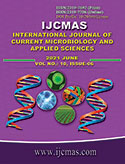


 National Academy of Agricultural Sciences (NAAS)
National Academy of Agricultural Sciences (NAAS)

|
PRINT ISSN : 2319-7692
Online ISSN : 2319-7706 Issues : 12 per year Publisher : Excellent Publishers Email : editorijcmas@gmail.com / submit@ijcmas.com Editor-in-chief: Dr.M.Prakash Index Copernicus ICV 2018: 95.39 NAAS RATING 2020: 5.38 |
Field experiments were conducted for two consecutive years during kharif 2018-19 and 2019-20 to study the effect of drip irrigation and fertigation levels on growth and yield attributes of pigeonpea. The experiment was carried out in split plot design where in four irrigation levels viz. I1: Drip irrigation at 0.8 ETc, I2: Drip irrigation at 0.8 ETc I3: Drip irrigation at 1.0 ETc and I4: Conventional method (surface irrigation of 60 mm each at critical growth stages like bud initiation, flowering and pod formation stage as per the situation) and sub plots were allotted to four fertigation levels viz. F1: Control (No fertilizer application), F2: 80% RDF (20 : 40 : 20 NPK kg ha-1), F3: 100% RDF (25 : 50 : 25 NPK kg ha-1) and F4:120 % RDF (30 : 60 : 30 NPK kg ha-1) and thus sixteen treatment combinations were replicated thrice. The results of experiment revealed that application of drip irrigation at 1.0 ETc scheduled at alternate day recorded significantly higher growth parameters viz. plant height, number of branches plant-1 and total dry matter accumulation plant-1 however; it was at par with irrigation level 0.8 ETc. While application of drip irrigation at 0.8 ETc scheduled at alternate day recorded significantly higher yield attributes viz. No. of pods plant-1, weight of pods plant-1 (g) and seed yield plant-1 (g) over rest of the irrigation levels. Drip fertigation with 30:60:30 NPK kg ha-1 (120% RDF) recorded significantly higher growth parameters like plant height, number of branches plant-1 and total dry matter accumulation plant-1, however it was at par with 25:50:25 NPK kg ha-1 (100% RDF). While application of drip fertigation with 25:50:25 NPK kg ha-1 (100%RDF) recorded significantly higher yield attributes viz., number of pods plant-1, pod weight plant-1 (g) and seed yield plant-1 (g).
 |
 |
 |
 |
 |